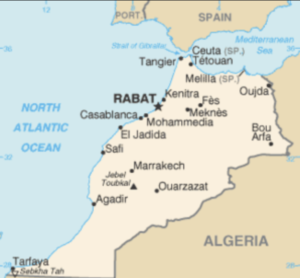 Jewish Population
Jewish Population
1948: 265,000 | 2018: 2,200
The Jewish presence dates back over 2,500 years. Under the Marinid dynasty of Zenata Berber descent that ruled Morocco from the 13th to the 15th century, Jews wielded great influence in both the political and spiritual domains. The arrival of Spanish Jewish refugees brought important changes in city life and within the preexisting Jewish community. While many Spanish Jewish exiles to Morocco were able to successfully integrate into the larger community in part due to their relative wealth, the problem of poverty among exiles still left a significant number of Jewish refugees vulnerable. Many died of hunger and some returned to Spain; most fled to Fez, where new challenges awaited them. More than 20,000 Jews died in and around Fez following a terrible fire and subsequent famine in the Jewish quarter of the city.
New Christians came to Morocco through the establishment of the Inquisition in Portugal under Pope Paul III in 1536. In 1508, Portugal had come to occupy parts of Morocco, succeeding in conquering the old seaport town of Safi, which had a large number of Jewish inhabitants and had subsequently become an important commercial center. In 1510, Safi was besieged by a large Moorish army. Following this, some Portuguese Jews brought assistance to the besieged with ships manned by coreligionists and equipped at their own cost. Beginning in the 15th century, the Jews of Fez were forced to live in special quarters called “Mellah.”
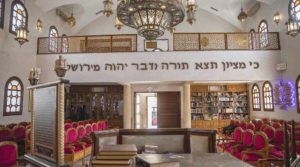 The 19th century, which brought emancipation to the Jews of many countries, failed to fundamentally alter the status of Moroccan Jews, but entailed new sources of trouble. In the mid 19th century, commercial development and European economic penetration brought prosperity to many Jewish merchants in northern Moroccan ports, but cost many Jews in the interior their traditional livelihoods, as industrial imports from Europe drove traditional Jewish crafts out of the market. As a result, Moroccan Jews started migrating from the interior to coastal cities such as Essaouira, Mazagan, Asfi, and later Casablanca for economic opportunity, participating in trade with Europeans and the development of those cities.
The 19th century, which brought emancipation to the Jews of many countries, failed to fundamentally alter the status of Moroccan Jews, but entailed new sources of trouble. In the mid 19th century, commercial development and European economic penetration brought prosperity to many Jewish merchants in northern Moroccan ports, but cost many Jews in the interior their traditional livelihoods, as industrial imports from Europe drove traditional Jewish crafts out of the market. As a result, Moroccan Jews started migrating from the interior to coastal cities such as Essaouira, Mazagan, Asfi, and later Casablanca for economic opportunity, participating in trade with Europeans and the development of those cities.
The First Franco-Moroccan War in 1844 brought new misery and ill treatment upon the Moroccan Jews, especially upon those of Essaouira. When the Hispano-Moroccan War broke out on September 22, 1859, the Mellah of Tetuan was sacked, and many Jews fled to Cadiz and Gibraltar for refuge. The status of Moroccan Jews was not substantially improved by the establishment in 1912 of a French protectorate over much of the country. Amid the insurrection that followed the disclosure of the Treaty of Fez, thousands of rebelling Moroccan soldiers entered and pillaged the Mellah of Fez. More than 50 Jews were killed and hundreds of homes and shops were destroyed or damaged. The events were known as Bloody Days of Fez or the Tritel.
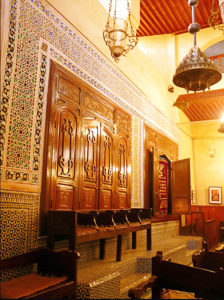 Morocco’s King Mohammed V met with representatives from Nazi Germany and Vichy France during the Holocaust to discuss the issue of Jews in Morocco. The Moroccan King famously stated at the meeting that in his country, there are no Jewish citizens, there are no Muslims citizens, they are all Moroccans. The Jews of Morocco were not sent away to concentration camps, and were not subject to the full brunt of Nazi evil. Although Jews were not deported during the war, they did suffer humiliation under the Vichy government. Following the U.S. landing in 1943, a few pogroms did occur.
Morocco’s King Mohammed V met with representatives from Nazi Germany and Vichy France during the Holocaust to discuss the issue of Jews in Morocco. The Moroccan King famously stated at the meeting that in his country, there are no Jewish citizens, there are no Muslims citizens, they are all Moroccans. The Jews of Morocco were not sent away to concentration camps, and were not subject to the full brunt of Nazi evil. Although Jews were not deported during the war, they did suffer humiliation under the Vichy government. Following the U.S. landing in 1943, a few pogroms did occur.
In 1948, approximately 270,000 Jews lived in Morocco. In June 1948, soon after Israel was established and in the midst of the first Arab-Israeli war, riots against Jews broke out in Oujda and Djerada, and in Alcazarquivir killing 44 Jews. In 1948–9, 18,000 Jews left the country for Israel. After this, Jewish emigration continued to Israel, France, the United States, and Canada. Through the early 1950s, Zionist organizations encouraged emigration. In the 1950s and 1960s there were still active Jewish schools and organizations such as the Alliance Israélite Universelle which later closed as the Jewish population decreased.
In 1956, Morocco attained independence and emigration to Israel jumped to 24,994 in 1955. Beginning in 1956, emigration to Israel was prohibited until 1961, although it continued illegally until it was officially resumed. In 1961, the government relaxed the laws on emigration to Israel, as part of an agreement with Israel that entailed a payment to Morocco for each Jew that left the country for Israel. Over the next three years, more than 80,000 Moroccan Jews immigrated to Israel. By 1967, only 60,000 Jews remained in Morocco.
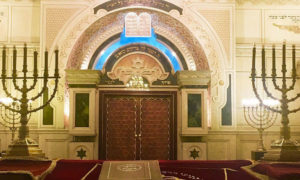 The Six-Day War in 1967 led to increased Arab-Jewish tensions worldwide including in Morocco. By 1971, its Jewish population was down to 35,000; however, most of this new wave of emigration went to Europe and North America rather than Israel. France for a time was a destination particularly for Moroccan Jews with a European education. By 1975, just 20,000 Jews were left.
The Six-Day War in 1967 led to increased Arab-Jewish tensions worldwide including in Morocco. By 1971, its Jewish population was down to 35,000; however, most of this new wave of emigration went to Europe and North America rather than Israel. France for a time was a destination particularly for Moroccan Jews with a European education. By 1975, just 20,000 Jews were left.
Morocco is perhaps Israel’s closest friend in the Arab world. King Hassan often tried to be a behind-the-scenes catalyst in the Arab-Israeli peace process. In July 1986, he hosted Israeli Prime Minister Shimon Peres in an effort to stimulate progress. Two months later, Hassan met with a delegation of Jews of Moroccan origin, including an Israeli Knesset member. In 1993, after signing the agreement with the PLO, Prime Minister Yitzhak Rabin paid a formal visit to Morocco. In May 1999, King Hassan organized the first meeting of the World Union of Moroccan Jews, in Marrakech.
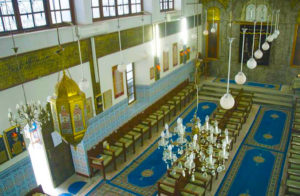 Since the ascension to the throne of Mohammed VI in 1999 there has been a significant improvement in the Kingdom’s attitude toward its Jewish community. In 2010, the King announced a new initiative to restore Jewish cemeteries in Morocco. The following year a new constitution was approved which recognized the rights of religious minorities, including the Jewish community.
Since the ascension to the throne of Mohammed VI in 1999 there has been a significant improvement in the Kingdom’s attitude toward its Jewish community. In 2010, the King announced a new initiative to restore Jewish cemeteries in Morocco. The following year a new constitution was approved which recognized the rights of religious minorities, including the Jewish community.
On May 16, 2003, a series of suicide bombers attacked four Jewish targets in Casablanca making the Jewish population feel insecure and despite King Mohammed VI’s support and his family’s traditional protection for the Jewish community, Jews left Morocco.
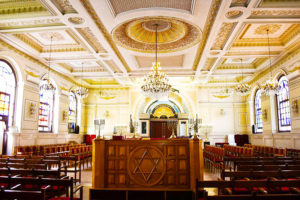 In 2013 the Varzea cemetery in the Island of Cape Verde was restored with the crown’s support and three years later the King attended the rededication ceremony of the Ettedgui Synagogue in Casablanca. The rededication of the Synagogue followed the re-opening of the El Mellah Museum, which chronicles the history of Moroccan Jewry. As of 2017, Morocco has gone to great lengths to revive its Jewish heritage. The country has restored 110 synagogues and has the Arab world’s only Jewish museum. More than 50,000 Israelis visit Morocco annually.
In 2013 the Varzea cemetery in the Island of Cape Verde was restored with the crown’s support and three years later the King attended the rededication ceremony of the Ettedgui Synagogue in Casablanca. The rededication of the Synagogue followed the re-opening of the El Mellah Museum, which chronicles the history of Moroccan Jewry. As of 2017, Morocco has gone to great lengths to revive its Jewish heritage. The country has restored 110 synagogues and has the Arab world’s only Jewish museum. More than 50,000 Israelis visit Morocco annually.
As of 2018 the total of Jews in Morocco is around 2,200. Today the largest community is in Casablanca, which is home to around 1,000 Jews. There are also small Jewish communities in Rabat (400), Marrakesh (250), Meknes (250), Tangier (150), Fez (150), and Tétouan (100). The last Moroccan Jewish day school, Neve Shalom, is in Casablanca. There are 15 functioning synagogues and five kosher restaurants.